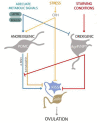Chronic Stress and Ovulatory Dysfunction: Implications in Times of COVID-19
- PMID: 35677754
- PMCID: PMC9168655
- DOI: 10.3389/fgwh.2022.866104
Chronic Stress and Ovulatory Dysfunction: Implications in Times of COVID-19
Abstract
Stress is known to be associated with adverse health outcomes. The COVID-19 pandemic and its associated lockdowns are examples of chronic stressors. Lockdown measures inadvertently caused significant psychological distress and became a powerful source of anxiety/stress, sleep disturbances, nutritional changes and weight gain. Stress is known to impact women's health specifically, through hypothalamic-pituitary-gonadal (HPG) axis dysfunction and resultant ovulatory dysfunction. Such dysfunction may manifest in menstrual irregularities and/or infertility due to hypothalamic hypogonadism. Here, we review the key physiological mediators of stress and associated ovulatory dysfunction. The kisspeptinergic system is comprised of sets of neurons located in the hypothalamus, the rostral periventricular region of the third ventricle (RP3V) and the arcuate nucleus (ARC). This system links nutrition, reproductive signals and stress. It plays a key role in the function of the HPG axis. During chronic stress, the kisspeptinergic system affects the HPG axis, GnRH pulsatility, and, therefore, ovulation. Leptin, insulin and corticotrophin-releasing hormone (CRH) are thought to be additional key modulators in the behavioral responses to chronic stress and may contribute to stress-related ovulatory dysfunction. This mini-review also summarizes and appraises the available evidence on the negative impact of chronic stress as a result of the COVID-19 pandemic lockdowns. It proposes physiological mechanisms to explain the observed effects on women's reproductive health and well-being. The review suggests areas for future research.
Keywords: anxiety; kisspeptin; menstrual cycle; obesity; ovulation; stress.
Copyright © 2022 Vigil, Meléndez, Soto, Petkovic, Bernal and Molina.
Conflict of interest statement
The authors declare that the research was conducted in the absence of any commercial or financial relationships that could be construed as a potential conflict of interest.
Figures


Similar articles
-
Kobayashi Award 2019: The neuroendocrine regulation of the mammalian reproduction.Gen Comp Endocrinol. 2022 Jan 1;315:113755. doi: 10.1016/j.ygcen.2021.113755. Epub 2021 Mar 10. Gen Comp Endocrinol. 2022. PMID: 33711315
-
The role of kisspeptin neurons in reproduction and metabolism.J Endocrinol. 2018 Sep;238(3):R173-R183. doi: 10.1530/JOE-18-0108. J Endocrinol. 2018. PMID: 30042117 Review.
-
Leptin deficiency and diet-induced obesity reduce hypothalamic kisspeptin expression in mice.Endocrinology. 2011 Apr;152(4):1541-50. doi: 10.1210/en.2010-1100. Epub 2011 Feb 15. Endocrinology. 2011. PMID: 21325051 Free PMC article.
-
Dominant Neuropeptide Cotransmission in Kisspeptin-GABA Regulation of GnRH Neuron Firing Driving Ovulation.J Neurosci. 2018 Jul 11;38(28):6310-6322. doi: 10.1523/JNEUROSCI.0658-18.2018. Epub 2018 Jun 13. J Neurosci. 2018. PMID: 29899026 Free PMC article.
-
Role of kisspeptin neurons as a GnRH surge generator: Comparative aspects in rodents and non-rodent mammals.J Obstet Gynaecol Res. 2019 Dec;45(12):2318-2329. doi: 10.1111/jog.14124. Epub 2019 Oct 13. J Obstet Gynaecol Res. 2019. PMID: 31608564 Review.
Cited by
-
Anti-COVID-19 Vaccination Alters the Menstrual Cycle and Dose Accumulation Enhances the Effect.Medicina (Kaunas). 2024 Jun 8;60(6):956. doi: 10.3390/medicina60060956. Medicina (Kaunas). 2024. PMID: 38929574 Free PMC article.
-
Menstrual Changes after COVID-19 Infection and COVID-19 Vaccination.Int J Clin Pract. 2022 Oct 27;2022:3199758. doi: 10.1155/2022/3199758. eCollection 2022. Int J Clin Pract. 2022. PMID: 36349056 Free PMC article.
-
Innovative Approaches to Menstruation and Fertility Tracking Using Wearable Reproductive Health Technology: Systematic Review.J Med Internet Res. 2024 Feb 15;26:e45139. doi: 10.2196/45139. J Med Internet Res. 2024. PMID: 38358798 Free PMC article.
-
Potential biomarkers to predict return to fertility after discontinuation of female contraceptives-looking to the future.Front Reprod Health. 2023 Aug 22;5:1210083. doi: 10.3389/frph.2023.1210083. eCollection 2023. Front Reprod Health. 2023. PMID: 37674657 Free PMC article. Review.
-
Effects of Liquid Fructose Supplementation and Chronic Unpredictable Stress on Uterine Contractile Activity in Nonpregnant Rats.Int J Mol Sci. 2024 Jun 20;25(12):6770. doi: 10.3390/ijms25126770. Int J Mol Sci. 2024. PMID: 38928475 Free PMC article.
References
Publication types
LinkOut - more resources
Full Text Sources

